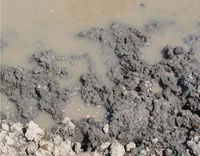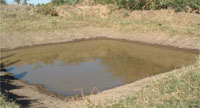9.2.4 Common vector breeding grounds in Ethiopia
In this section, we summarise the environmental control measures that will be most useful and appropriate in dealing with common mosquito breeding sites in Ethiopia.
Accumulations of water near roads
The construction of roads often leads to the creation of water collections that serve as vector breeding grounds. It often prevents natural drainage of the land and may result in the formation of large ponds alongside the roads.
Control measures include:
- Construction of underground channels allowing streams to continue on their natural courses.
- Use of larvicides (see Section 9.3).
Borrow-pits
Borrow-pits used to extract soil and stones for construction are very common in rural Ethiopia inside and outside villages. Older pits containing vegetation and freshly dug pits collecting rain water (Figure 9.7) can serve as very important vector breeding sites.

Control measures include:
- Filling with mud and stones, or the disposal of household rubbish or waste. Filling the pits with rubbish or waste would also pollute the water, making it unfavorable for breeding of the malaria vectors, which normally prefer clean water.
- The removal of water plants and other mosquito shelters can make ponds temporarily unsuitable for breeding by mosquitoes.
Micro-ponds
Micro-ponds are the most common man-made structures in Ethiopia, and are used to harvest rain water for horticulture and small scale irrigation. There are several types of micro-ponds in use. Some are lined with plastic sheet to prevent seepage and some are covered to avoid evaporation. The plastic lining prevents vegetation growth, making it unfavourable for mosquito breeding; covering the ponds denies access to egg-laying mosquitoes. However, many micro-ponds are neither lined nor roofed and serve as very important vector breeding grounds. Moreover, the location of these ponds very close to houses makes them extremely dangerous sites in terms of malaria transmission.
Control measures include:
- Removal of vegetation along margins and steepening shorelines (Figure 9.8) reduces the breeding of vector mosquito species temporarily by taking away protective cover and removing shallows.
- Apply chemical larvicides (see Section 9.3).

Rivers and creeks
Mosquitoes breed in quiet places close to the banks of rivers and creeks where there is protection from currents by obstacles, protruding roots, plants and so on. Effective control of larvae is generally difficult because of the large areas to be covered. Careful study is required to find out the exact location of the breeding sites. During the dry season mosquitoes may breed in stagnant pools in river beds.
Control measures include:
- Breeding sites may be reduced in some cases by removing obstructions in streams, removing vegetation from river edges, and smoothing and increasing the steepness of the banks to increase the speed of the flowing water.
- In the dry season, pools may form in river beds. If breeding occurs in such pools, they can be drained into the main stream. Some smaller pools may be filled up.
- Pools in river beds may be treated with larvicides (see Section 9.3).
Irrigation
Many development-linked activities (e.g. irrigation) lead to environmental changes and often inadvertently increase the risk of malaria transmission. Appropriate safeguards and actions to reduce the risk are required in the planning, construction, and maintenance phases of development projects. Irrigation canals should be lined and the vegetation cleared to discourage breeding in the canal edges and allow free flow of water. The intervals between releasing a gush of water from an upstream dam can be adjusted to ensure adequate periodic flushing of larvae from pools in the canal beds.
9.2.3 Environmental manipulation
